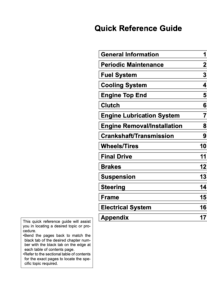Complete PDF version of the Service Manual for the Kawasaki Bajaj Pulsar/Rouser 200 NS. A MUST for every Pulsar/Rouser 200 NS owner.
Download: Immediately after payment!
OEM Original factory workshop manual.
Models covered by this manual: 2012-2014
Number of pages: 411 pages
Table of contents:

This PDF repair manual can be downloaded right after the payment process in complete, on the device of your choice.
We do not offer printed manuals, for the following reasons:
- it is more eco-friendly to use a digital version
- your manual never gets dirty or greasy
- you can always choose to print the specific page(s) you need to work on your bike
- you receive your manual immediately after payment
- it is searchable
Kawasaki Bajaj Pulsar 200 NS
The Bajaj Pulsar is a motorbike line produced by Bajaj Auto in India. It was created by Bajaj Auto’s product engineering division in collaboration with Tokyo R&D, and later with motorcycle designer Glynn Kerr. The Pulsar 200NS, a variation of the bike, was released in 2012, however it was later halted (reintroduced in early 2017 with BS IV Emission compliance and renamed the NS200). Pulsar claimed a 47 percent market share in its sector in 2011 with average monthly sales of roughly 86,000 units. By April 2012, more than five million Pulsar units had been sold. In 2018, they commemorated selling over 10 million Pulsars by supporting an exclusive TV ad and a marquee ride in six locations. In 2018, they commemorated the sale of 10 million Pulsars with an exclusive TV ad and a marquee ride in six cities to write “PULSAR” on a pre-determined path.
Prior to the debut of the Pulsar, the Indian motorcycle industry was trending toward fuel-efficient, small-capacity bikes (80–125 cc class). Larger, more powerful bikes were essentially non-existent (except for Royal Enfield Bullet with 350cc and 500cc variants). The development and popularity of the Hero Honda CBZ in 1999 demonstrated that there was a market for high-performance motorcycles. From then, Bajaj grabbed the lead and debuted the Pulsar twins (150cc and 180cc) in India on November 24, 2001. Since the debut and popularity of the Bajaj Pulsar, Indian youngsters have come to demand tremendous power and other amenities from reasonably priced bikes.
The proposal encountered internal opposition, misgivings from McKinsey & Company, and concerns about its impact on Bajaj’s relationship with Kawasaki. The project took around 36 months to complete and cost Bajaj one billion rupees.
The Bajaj Pulsar “Twins” were introduced on November 24, 2001. The first-generation Pulsar had a 150/180cc two-valve, air-cooled, single-cylinder, four-stroke engine that produced 12/15 horsepower. It had a single spark plug to start the carbureted air-fuel combination, basic spring shock absorbers, a circular headlight dome, a large 18 L fuel tank, and a 1,265 mm wheelbase. Disc brakes as standard equipment on Indian bikes in the early 2000s were a novelty.
The 180 cc version produced 15 horsepower and had a twin-tone horn, which was optional on the 150 cc version. The 180 cc model came standard with Electric Start (ES) and Engine Killswitch, while the 150 cc variant was optional.
2012
The Pulsar 200NS, Bajaj’s most recent design, made its debut in 2012. (NS standing for Naked-Sport). The bike is powered by a 200 cc liquid-cooled engine borrowed from the KTM 200 Duke that develops 23.17 bhp (17.28 kW) at 9,500 rpm and 18.3 Nm (13.5 lbft) at 8,000 rpm. It has a new triple-spark design as well as a new four-valve SOHC. The firm claims a peak speed of 136 kilometers per hour (85 mph). It lacks fuel injection, as did its predecessor, the Pulsar 220Fi. It sports a front disc brake with petal discs, a rear disc brake, and a gas-charged monoshock. It was released in April of 2012. When ridden at less than 60 kilometers per hour, the claimed fuel efficiency is 58 kilometers per litre (140 mpg US) (37 mph). The 200NS was designed by Bajaj chief designer Edgar Heinrich, who departed Bajaj in mid-2012 to become head of BMW Motorrad design.
Source: Topspeed


